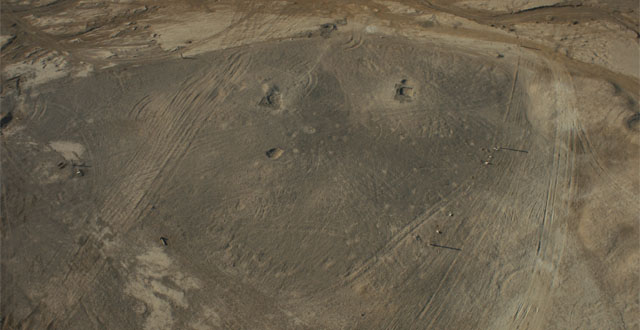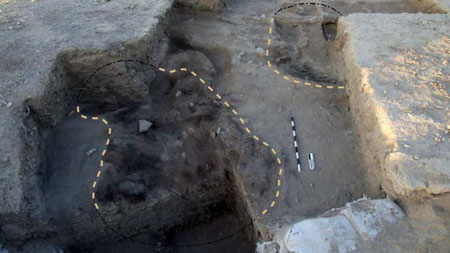A joint British, Danish, American and Jordanian team of archaeologists has discovered 20,000-year-old hut structures at the archaeological site of Kharaneh IV in eastern Jordan.

© I. RubenAn aerial view of Kharaneh IV site.
the discovery suggests that the area was once intensively occupied and that the origins of architecture in the region date back twenty millennia, before the emergence of agriculture.
A paper,
published in the journal PLoS-ONE, describes huts that hunter-gatherers used as long-term residences and suggests that many behaviors that have been associated with later cultures and communities, such as a growing attachment to a location and a far-reaching social network, existed up to 10,000 years earlier.
"What we witness at the site of Kharaneh IV in the Jordanian desert is an enormous concentration of people in one place," said Dr. Jay Stock from the Department of Archaeology and Anthropology at the University of Cambridge, a co-author on the paper.
"People lived here for considerable periods of time when these huts were built. They exchanged objects with other groups in the region and even buried their dead at the site. These activities precede the settlements associated with the emergence of agriculture, which replaced hunting and gathering later on. At Kharaneh IV we have been able to document similar behavior a full 10,000 years before agriculture appears on the scene."

© Lisa Maher20,000-year-old buildings.
So far, the archaeologists have fully excavated two huts, but there may be several more hidden beneath the desert's sands.
"They're not large by any means. They measure about 2 - 3 m in maximum length and were dug into the ground. The walls and roof were made of brush wood, which then burnt and collapsed leaving dark colored marks," said Dr. Tobias Richter of the University of Copenhagen, one of the project's co-directors.
Radiocarbon dating suggests that these huts are between 19,300 and 18,600 years old.
The team also uncovered hundreds of thousands of stone tools, animal bones and rarer items such as shell beads, bones with regularly incised lines and a fragment of limestone with geometric carved patterns.
"Inside the huts, we found intentionally burnt piles of gazelle horn cores, clumps of red ochre pigment and a cache of hundreds of pierced marine shells," said Dr. Lisa Maher of the University of California, who spearheads the excavations. "These shell beads were brought to the site from the Mediterranean and Red Sea over 250 km away, showing that people were very well linked to regional social networks and exchanged items across considerable distances."
"It may not look very impressive to the untrained eye, but it is one of the densest and largest Palaeolithic open-air sites in the region," Dr. Maher concluded.


Reader Comments
to our Newsletter